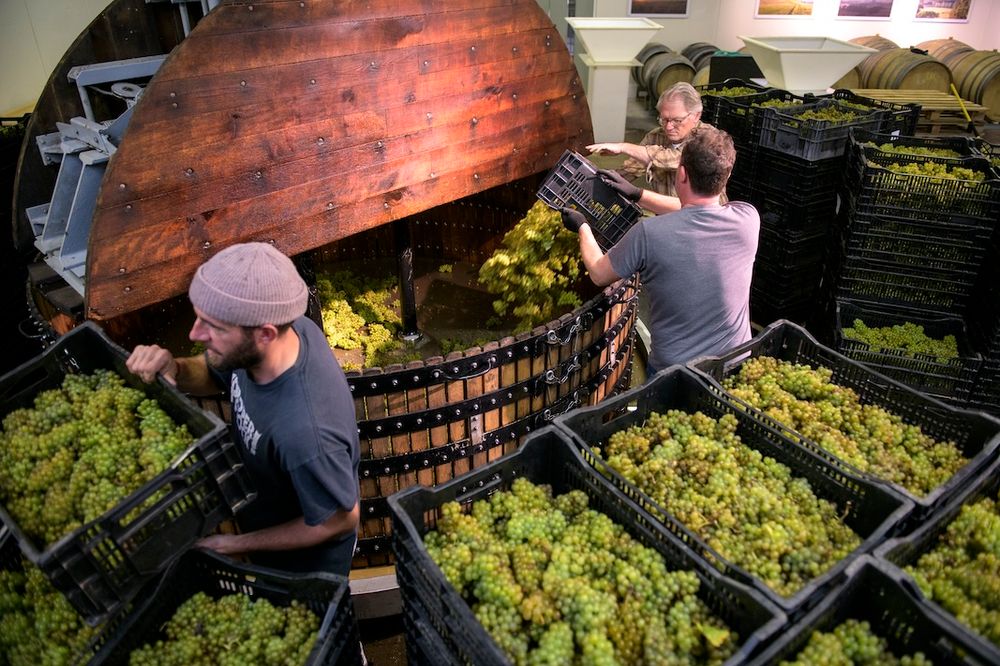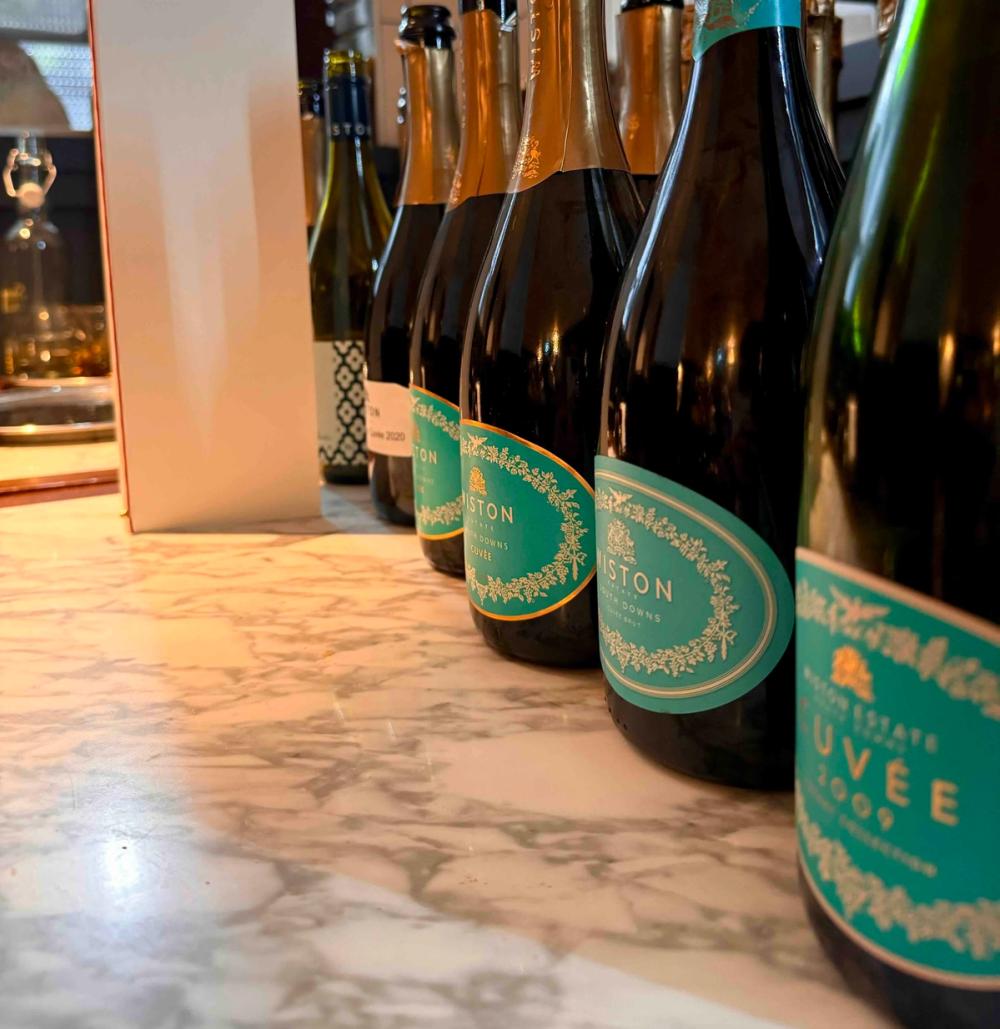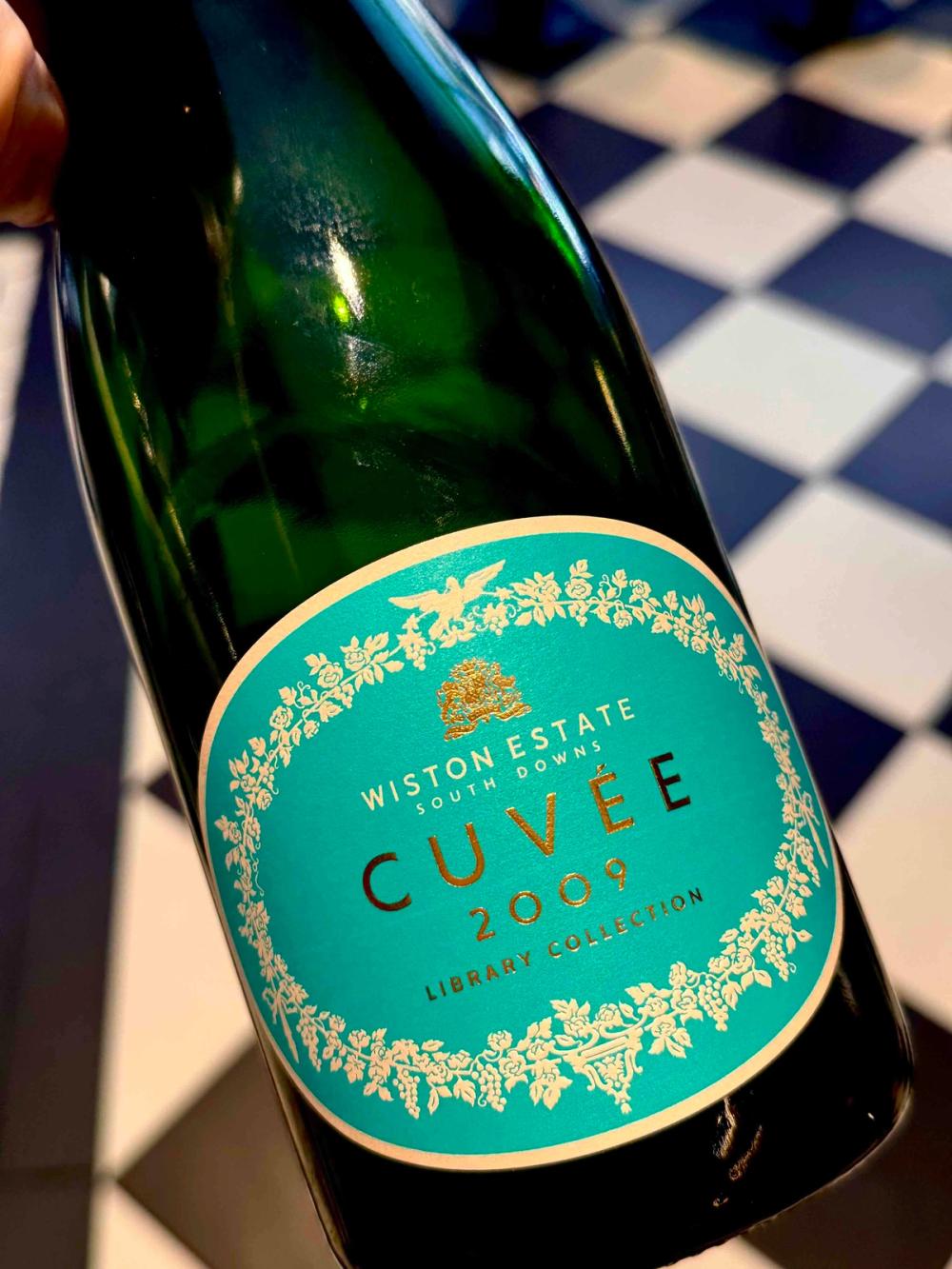A homesick South African bride, an ancient estate in the South Downs, decades of persuasion and a stupendous maiden vintage – some stories are just brilliant – especially when they are encapsulated in a stupendous glass of fine fizz.

Kirsty Goring tells her family story at the launch of Wiston Estate Library Collection Cuvée 2009
The wallpaper of life
The wine in question is the Wiston Estate Library Collection Cuvée 2009, the bride is the irrepressible life force Pip Goring, the estate is Wiston and the wine is the result of years of longing and a big leap of faith. It fell to Kirsty Goring to tell her family’s compelling story at the library release of this late-disgorged English sparkling wine from the first commercial vintage, made from vines planted in 2006.
“I married into the Goring family, and they have been in this place in Sussex for 280 years. Historically we are farmers who have had a lot of wheat, barley, sheep and cattle. When my father-in-law took over the estate, he thought he was going to take off and it was not a trendy thing to go and do a gap year then, and he went to South Africa. He came back with Pip in 1972,” Goring said, speaking about her parents-in-law Pip and Harry Goring.
By now, Kirsty and her husband Richard have taken over the running of Wiston. She continued with her fast-paced account, neatly packing three decades into a few short sentences:
“Pip felt homesick and asked Harry if he could plant some vines because it was the wallpaper of her life in South Africa. She had grown up on a farm and she found it so strange that there were acres and acres, and they did not eat or drink a single thing off the land. Harry thought this was early days, that she would get over his – and it was not until two French Champagne houses came who wanted to lease or buy land, that Harry changed his mind.”

The 50-year-old Coquard press that all Wiston wine is pressed in
The leap of faith
Indeed, Pip Goring had gone on and on about vines at the estate for three decades since her arrival as a young bride. But she had to be patient. There also was real interest from the Champenois to acquire land in the South of England and it was their prospecting in 2006 that persuaded the Gorings to give it a go.
It was the world financial crisis of 2007/08 that put a kibosh on these early foreign investments which only took off again a decade later with Champagne Pommery planting Pringlestone in 2016 and Champagne Taittinger planting Domaine Evremond in 2017.
It is hard to imagine today with the English wine industry in expansion mode, but in the 2000s there was still a lot of doubt about English sparkling wine, despite Stuart and Sandy Moss planting Champagne varieties all the way back in 1988 for that very purpose and a first release in 1997. Camel Valley first planted in 1989, Ridgeview in 1995, Hush Heath/Balfour in 2002 and Gusbourne in 2004 – so there was a surge but scepticism, too.
But back to the Gorings: now they had made the decision to give it a go, they sold their dairy herd to finance their new venture. They planted the Findon Park Vineyard on pure chalk with just a little topsoil in 2006 and harvested the first fruit in 2008 – as Goring said with a few wines made just “for family and friends.”
The first real vintage
2009 was the first real harvest. “And this is why it is really exciting to launch this 2009 Library Collection today,” Goring said, “because this was really our first commercial vintage. It was the first vintage where we knew we’ve got something serious.”
She then paid homage to Wiston’s first winemaker, the inimitable Dermot Sugrue who had left Nyetimber and helped the entire Wiston project along by sourcing essential equipment on a relative shoestring, like the 50-year-old Coquard press that all Wiston wine is still pressed in.
Today, the wines are made by Marcus Rayner-Ward. He worked alongside Sugrue for six years before stepping up to the head winemaker role.
“We are unbelievably proud of what Marcus has taken on, staying light in touch as a winemaker and respecting the land,” Goring said.
Then Rayner-Ward recalled how much he had learned since joining Wiston in 2018. He noted that “Dermot was very innovative in the way he approached winemaking at the start. He did not want to hide acidity – a lot of people did. Because he knew what the acidity would bring in terms of longevity.”
The proof was in the glass as the Wiston Estate Cuvées from 2016, 2015 and 2103 were shown, all original disgorgements with 2016 being the current release to build up to the 2009 late-disgorged library release, Wiston Estate Library Collection Cuvée 2009
How the wine is made
Rayner-Ward said the sparkling wines were always pressed in the Coquard press and fermented in used Burgundian barrels.
“That gives a texture,” he said. “and a bit of evaporation, so concentration as well. The wine stays in there for nine months, and we stir the lees a little. We are not adding loads of product, we are not doing malo-lactic, we just want to have the expression of the vineyard.”
The non-released 2020 was shown at the beginning of the tasting but did not really measure up to the other wines yet with less time on lees. All the wines showed beautiful straightness – for Rayner-Ward this was the estate-typical acidity which he described fittingly as “a bullet train.” T
he 2015 showed lovely chalkiness while the 2013 clearly benefitted from its post-disgorgement ageing, showing smooth evolution – a promise perhaps for how the incredibly youthful and late-disgorged 2009 will develop?
Kirsty Goring noted that the 2009 was made from “unbelievably young vines.” Initially 980 bottles of a total production of 6,000 bottles were held back – and the last wines were disgorged now. While the family kept a small amount for their own library stock, Kirsty said “this is the last release of this wine.” It is a beautiful jewel that encapsulates a wish come true – even if it took decades to become reality.
So how were the wines tasting?

Wiston Estate Cuvée 2016 12% ABV
55% Pinot Noir, 33% Chardonnay, 12% Pinot Meunier, disgorged in June 2023 with 8g/l dosage
This is savoury from the off, with salty polenta and a hint of roast chicken skin, followed by a smooth and subtle crumbly biscuit saltiness. More air shows absolute lemon exuberance. The palate comes with superfine, creamy mousse, beautiful and serene brightness that shines all the way along the textured, creamy finish, beautifully rich but svelte, strait-laced with lots of direction.
Wiston Estate Cuvée 2015 12% ABV
45% Pinot Noir, 35% Chardonnay, 20% Pinot Meunier, disgorged in October 2021 with 8g/l dosage
Golden. A pure, lifted note of dried lemon and lemon oil is serene on the nose with a touch of dried corn husk and compote of ripe, juicy Mirabelle, the latter showing the Pinot-dominance of the wine. The palate is immediately bright and vivid, with that vein of acidity becoming a central element of the wine, cutting right through the emollience of Pinot ripeness and supple, smooth yet understated autolysis. Long and expressive with a beautifully textured, really chalky finish.
Wiston Estate Cuvée 2013 12% ABV
47% Pinot Noir, 33% Chardonnay, 20% Pinot Meunier, disgorged in September 2016 with 8g/l dosage
The crunchy crust of blonde, freshly-baked baguette is subtle with lemon on the nose, emitting subtle toastiness. It is on the palate that gorgeous notes of torrefaction appear, like slightly toasted cashew, again with that superbly svelte, cool depth of chalk, with that contour, the vivid acidity tamed, now completely part of the body of this, dispersed by creamiest mousse, absolutely present but mellowed with age. Superb at this stage of its evolution and with plenty more mileage left.

Wiston Estate Library Collection Cuvée 2009 12% ABV
60% Chardonnay, 30% Pinot Noir, 10% Pinot Meunier, disgorged 16 January 2024 with 8g/l dosage
Creaminess and saltiness on the nose come with a sense of gentle powderiness that seems to stem from oak with creamy florality, and yes, Rayner-Ward confirmed that there had been some newer oak – not new but newer. Electric acidity immediately hits the palate. This is svelte, streamlined with really fine, creamy mousse – astonishingly youthful and deeply salty. The finish reveals the true nature of the wine: chalkiness, subtle and bright with a distinct and long umami aftertaste. Remarkable for such young wines in such a challenging soil as chalk. Wow.
The wines of Wiston Estate are sold and distributed in the UK by Fells which is a commercial partner of The Buyer. To discover more about them click here.
































